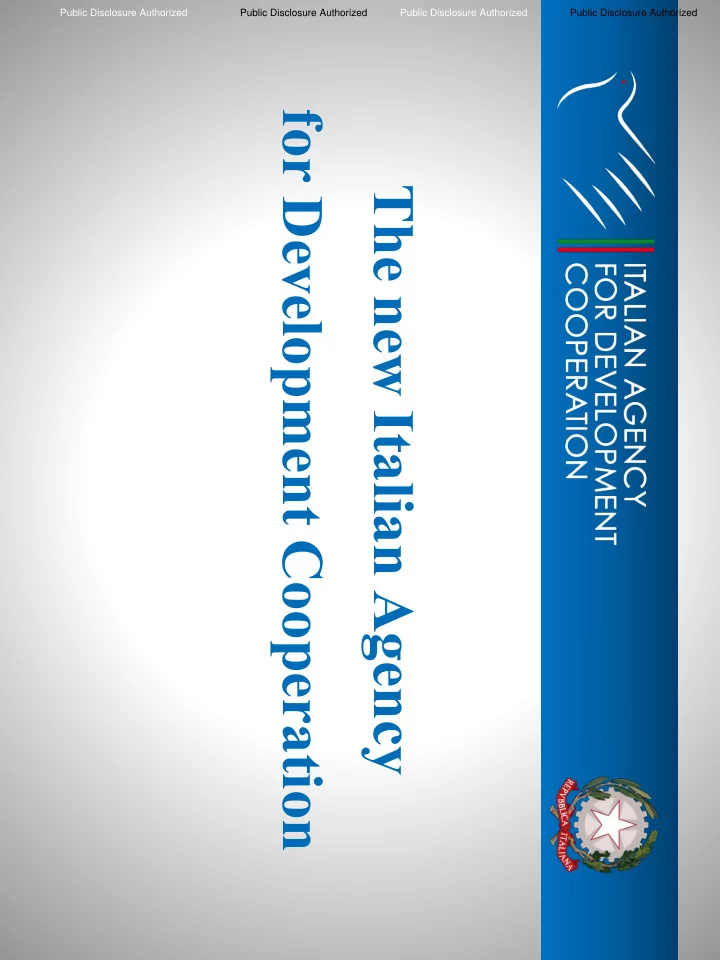

Public Disclosure Authorized Public Disclosure Authorized Public Disclosure Authorized Public Disclosure Authorized for Development Cooperation The new Italian Agency
A systemic reform for a new cooperation Italian L aw no. 125/ 20 14 defines development cooperation as an " integral and qualifying part " of the Italian f oreign p olicy . The law emphasizes the consistency of Italian cooperation policies with the fundamental goals of peace, justice, and supportive relations among peoples. The law endorses a system ic approach to development cooperation and to co-development initiatives, based on the local ownership of p artner s and the involvement of the private sector . As the operational engine of the Italian Cooperation, the law establishes the Italian Agency for Development Cooperation (AICS).
Aid structure Ministry of Foreign Affairs and International Cooperation Vice Minister for Development Cooperation CDP DGCS AICS Bank of Deposits and General Directorate Italian Agency Loans for Development for Development Cooperation Cooperation STRATEGY IMPLEMENTATION DEVELOPMENT BANK
DGCS Within the Ministry of Foreign Affairs and International Cooperation, the General Directorate for Development Cooperation (DGCS) is responsible for the following tasks: Supporting the Vice Minister in drafting strategic guidelines Setting political guidelines of Italian deevlopment cooperation both on bilateral and multilateral relations Elaborating proposals of voluntary contributions to multilateral agencies, humanitarian interventions and credit Assessing the impact of Italian cooperation initiatives and evaluating the achievement of planned objectives .
AICS The Agency is based in Rome , with a technical center in Florence . The network of AICS field offices in partner countries includes the following: Africa : Egypt, Ethiopia, Kenya, Mozambique, Senegal, Sudan, Tunisia. Europe : Albania. Middle-East : Lebanon, Palestine. Asia : Afghanistan, Pakistan, Myanmar, Vietnam. Latin America : Bolivia, El Salvador. Embassy-based AICS desk offices are present in Burkina Faso, Cuba, Morocco, Somalia and Syria. AICS staff worldwide: 350
Organizational chart Director Technical Administrative Area Area Vice Director Vice Director 1 – Planning and General 9 – Legal Affairs Affairs 2 – Institutional Relations and 10 – Financial planning, Communication Assets 3 – Economic 11 – Human Development Resources 4 – Human Development 5 – Environment and Natural Resources 6 – Rural Development and Food Security 7 – Emergency and Fragile States 8 – Civil society, partnerships, private sector
Technical Area Office # 3 – Economic Development and opportunities Local economic development, urban governance, professional training, institution building, statistics, cultural heritage, migrations. Office # 4 – Human Development Human rights, gender, equal opportunities, youth, disability, health, inclusion and social protection, education and training. Office # 5 – Environment and Use of Natural Resources Sustainable use of natural resources, environmental protection, climate change, ecosystems, biodiversity and protected areas, forests, desertification, infrastructures, transportation, sustainable urban development. Office # 6 – Rural Development and Food Security Rural development, agriculture, agro-pastoral systems, food security, nutrition. Office # 7 – Emergency and Fragile States Humanitarian aid, aid coordination, operative strategies, liason with other donors and partners.
CDP Cassa Depositi e Prestiti (CDP) will operate as the Italian development bank . The bank will be vital in strengthening the financial tools of the Italian cooperation, improving the partnership with International Financial Institutions, and playing as catalyst to involve private resources in the framework of public-private partnerships . Main activities: Blending MAECI/MEF resources with EU funding Blending own resources with MEF/MAECI assets for multilateral or bilateral funding Promoting private co-funding Providing credit for development
Priority Areas and Countries Sub-Saharan Africa - Burkina Faso, Senegal, Niger, Ethiopia, Kenya, Somalia, Sudan, South Sudan, Mozambique. Mediterranean and Middle East - Egypt, Jordan, Lebanon, Tunisia, Palestine. Balkans - Albania. Latin America and Caribbeans - Bolivia, Cuba, El Salvador. Asia - Afghanistan, Myanmar, Pakistan.
Priority Sectors The priority sectors of the Italian cooperation include the following: Human development : health and primary education Human rights and governance : gender, youth, disabilities, institutions Rural development : food security, sustainable agriculture Private enterprise : support to SMEs, cooperatives, trade
Resources ITALIAN OFFICIAL DEVELOPMENT ASSISTANCE 2007-2015 – (2015: provisional data) € million 2007 2008 2009 2010 2011 2012 2013 2014 2015 (*) Net ODA 2.900,54 3.369,88 2.367,93 2.262,27 3.110,54 2.129,49 2.592,36 3.021,72 3.007,13 GNI 1.527.378 1.548.138 1.494.576 1.528.056 1.569.735 1.554.522 1.550.648 1.614.001 1.625.299 % 0,19% 0,22% 0,16% 0,15% 0,19% 0,14% 0,17% 0,19% 0,19% Bilateral ODA per sector (2014, %) Bilateral ODA per area (2014, %)
Italian ODA: a possible scenario • The following scenario aims at an ambitious ODA/GNI ratio of 0.24 in 2016. Figures in € million 2013 2014 2015 2016 GDP growth rate (nominal) 0,7% 1,4% GNI (nominal) 1.550.648 1.614.001 1.625.299 1.648.053 ODA (absolute) 2.592,36 3.021,72 Estimated ODA (absolute) 3.007,13 3.889,41 Estimated ODA/GNI (%) 0,17% 0,19% 0,19% 0,24% Notes • ODA/GNI estimates for years 2015 and 2016 depend on GNI growth to be certified by ISTAT. • 2015 data are provisional as they do not include reports still to be filed to the Ministry of Foreign Affairs and International Cooperation by regional and local authorities. It is therefore possible that the final ODA/GNI ratio for 2015 reaches 0.20.
Recommend
More recommend